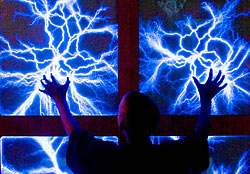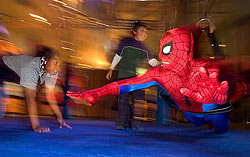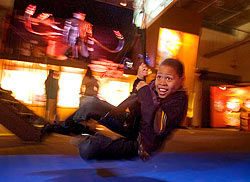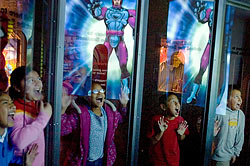
Sacramento Bee/Brian Baer |
|
A
Marvel-ous world
|
|
| Copyright © The Sacramento Bee | |
| http://www.sacbee.com/content/news/california/story/14234889p-15056331c.html | |
| LOS ANGELES - The doors
close on the industrial elevator and, through the magic of technology,
riders reach the rooftops of New York City and the universe of
superheroes.
In this gallery not so far away, Spider-Man and his comic book colleagues will battle a new villain - ignorance of science - at the world premiere of the Marvel Super Heroes Science Exhibition when it opens Sunday at the California Science Center. Visitors will learn about the strength of spider's silk by dangling from a re-creation of one of Spidey's webs. The Invisible Woman will disappear before their very eyes in a demonstration of how optical illusions work. And modern-day technology will give them Ironman's incredible strength to lift a car. Reflecting a growing trend in museums, this hands-on exhibition of superheroes' super powers seeks to make science fun for children and adults who may be more inclined to open up a comic book than a textbook."Museums are becoming entertainment," said Nicola Lisus, whose Canadian-based firm, Yellowbrick/Holman Exhibitions Inc., conceived and designed the superheroes show. "Good ones mix entertainment with education." Ever since the 1976 "Treasures of Tutankhamun" exhibit at the National Gallery of Art in Washington, D.C., drew more than 835,000 visitors, museums have increasingly turned to blockbuster promotions and exhibits, like this one, to boost their bottom line and compete with television and other attractions. "More museums are embracing it," Lisus said. "But some museums consider it this necessary evil, like the sugar-coated pill, when in fact it's not." In Sacramento, the Crocker Art Museum has to pass up these blockbuster shows because it doesn't have space for the large exhibits, said LeAnne Ruzzamenti, director of marketing. Mike McGee, California State University, Fullerton, art professor and gallery director, said blockbusters bring bigger ticket receipts that can make up for the decline in grants and donations that historically financed museums. But he said the shift to big-ticket shows can drain time and money from scholarly exhibits. "Hopefully, they do bring more people in who get to see things they wouldn't normally see," McGee said. "But the sad thing that seems to be happening is other programs that may not have the same glitz are being squeezed out." Lisus said museums could have both the glitz and the scholarship if exhibitions are properly designed. In the superheroes show, for instance, her firm collaborated with the Ontario Science Center and sought input from the California Science Center to ensure educational value. "Showing the Marvel comics is a good way to hook kids into scientific learning," said Diane Perlov, the California Science Center's senior vice president for exhibitions. "They will remember it and be inspired to learn about the science involved." Commercial tie-ins, like this show's link to Marvel, are becoming increasingly common in this formerly commercial-free world. The Museum of Science in Boston, for instance, set daily attendance records with its current exhibit of science and technology in the "Star Wars" movies. The Houston Museum of Natural Science broke its opening weekend attendance records with its June premiere of "The Lord of the Rings Motion Picture Trilogy" exhibit. The California Science Center capitalized on the popularity of the "Titanic" movie by hosting a display of artifacts from the sunken ship three years ago. In terms of promotion, though, each was outdone by King Tut's return to the United States last year. The nation's second-largest rock promoter, AEG, brokered, financed and promoted the show, prompting the New York Times to claim the exhibit outsourced "the museum's real job - curating content - to a commercial company." That didn't stop the public. During its five-month opening run at the Los Angeles County Museum of Art, King Tut's show set a record for ticket prices at $30 per adult on weekends and drew 937,613 - just short of AEG's goal of 1 million visitors. The goals for the superheroes show are small by comparison: Just 300,000 visitors are expected before the exhibit's Sept. 4 close. But it is getting a blockbuster promotion. Costumed characters greeted youngsters during a preview Wednesday, and the legendary comic book creator, Stan Lee, put in an appearance. Lee, along with Marvel's artists, created 90 percent of the brand's characters, including Spider-Man, the Incredible Hulk, X-Men and his personal favorite, the Silver Surfer. At age 83, he's seen his creations go far beyond the printed page to appear in movies, video games and theme parks. But this is his first time to see them in a museum. "It is so much more brilliant than I could have imagined," he said after touring the exhibit. Lee claimed little scientific knowledge of his own. He even admitted to being clueless about the gamma rays he used to turn Bruce Banner into the Hulk. "If you use enough scientific terms, it sounds like you know what you're talking about," he said with a grin. Seeing his fantastical, decidedly unscientific tales turned into science lessons that were fun left him almost speechless. "I can't get over it," he said. "I want to play with it myself." Elementary school students did just that during Wednesday's preview. They skittered across a climbing wall designed to give them an idea of how spiders grip walls. They re-created superhero Storm's control of the weather by touching an interactive lighting display to attract lightning-shaped lines of light. And they gleefully swung from harnesses hanging from a web of Technora, a synthetic material eight times stronger than steel but still weaker than real spider silk. "Webs are strong, huh?" Spider-Man asked the youngsters as he swung with them. "This is so cool!" exclaimed Kristine Soto, a wide-eyed 9-year-old. "It's like you practically have powers like Spider-Man." Perlov, the California Science Center's curator, said studies have shown youngsters learn more by these types of full-body interactions than reading or hearing about something. "Here, they can be immersed in the experience," she said. "We are hoping people will be inspired to learn more about the real-life science and technology that affects their lives."
IF YOU GOThe superheroes exhibit will be open from 10 a.m. to 5 p.m., Sunday through Sept. 4, at the California Science Center, 700 State Drive, Los Angeles. Admission is $9.75 for adults, $8.75 for seniors and students, and $7.75 for children. Tickets are available at www.californiasciencecenter.org.
Spider-Man, Marvel Comics' superhero and movie star, shows youthful visitors the strength of spider's silk Wednesday at the California Science Center in Los Angeles. Sacramento Bee/Brian Baer
Amir Abdul-Mujeeb, 10, gets into the swing of science education as he discovers just how sturdy Spider-Man's web can be by dangling on one of several swings that hang from a single thread at the Los Angeles exhibition on Wednesday. "Webs are strong, huh?" Spider-Man asked the kids. Sacramento Bee/Brian Baer
Students at the California Science Center explore the power of the human voice Wednesday as they scream at an exhibit that shows sound blowing up bad guys after reaching a certain level. Sacramento Bee/Brian Baer
|
|


